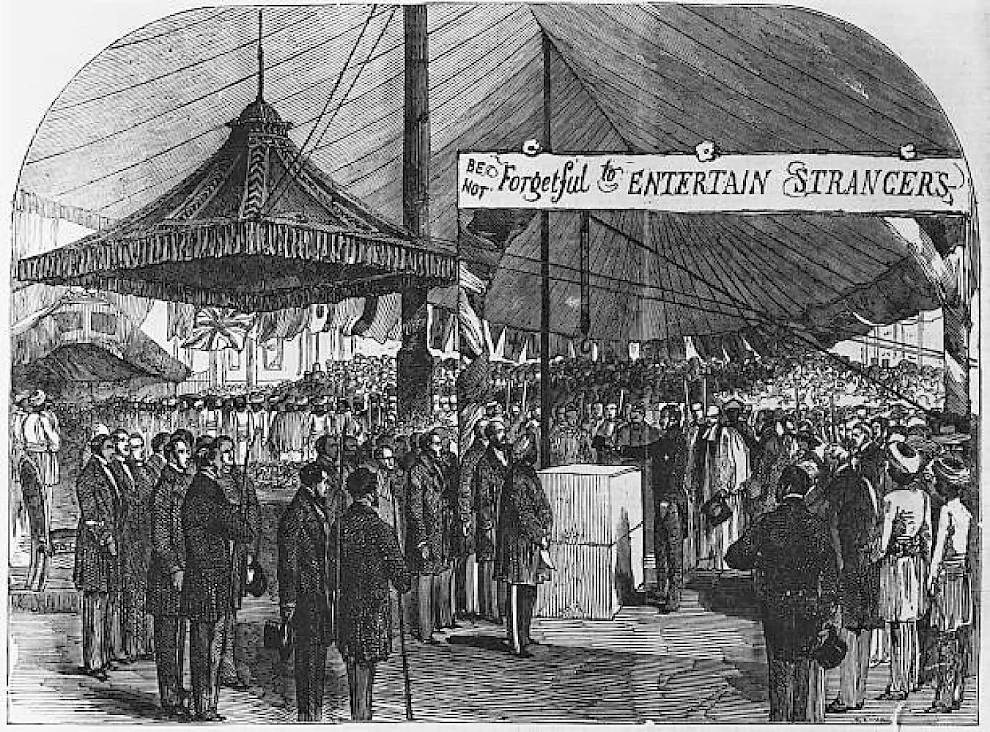
Laying of the Foundation Stone: Strangers’ Home for Asiatics, Africans and South Sea Islanders.
The foundation stone for The Strangers’ Home for Asiatics, Africans and South Sea Islanders was laid by Prince Albert on 31 May 1856.
Image: Prince Albert lays the foundation stone of the Strangers’ Home, 31 May 1856, Illustrated London News, 14 June 1856.
Source: Public Domain. Wikimedia Commons
At 4 o'clock on 31 May 1856, Prince Albert arrived in West India dock London to lay the foundation stone for The Strangers' Home for Asiatics, Africans and South Sea Islanders. The monarch was welcomed by waving crowds and surrounded by guests of different ethnicities in a room strewn with flags from the empire. A banner reading 'Be not forgetful to entertain strangers', was on display, a biblical reference from which the institution had taken its name. (London Evening Standard, 2 June 1856)
The London Evening Standard was among myriad papers that reported the event. It told readers that there had been much need for such an organisation, which was similar to other sailors home in the area, but catered to Asiatics or Africans 'whose ignorance of the language, manners and customs of the people render them an easy pray to those unprincipled persons who abound in the East end of London'.
The Stranger's Home was a product of intersecting but varied interests. The initiative to establish the institution was spearheaded by the secretary to the Church Mission Society, Henry Venn, and it received essential financial backing from Queen Victoria and Prince Albert, who donated £200 and £100, respectively. The greatest donation, however, was provided by the last maharaja of the Sikh Empire, Duleep Singh, a recent convert to Christianity (Salter, pp 9-12).
The Home opened in June 1857, just a year after the laying of the foundation stone. It had dormitories to accommodate 220 people, a depository where the men could store their valuables, a dining hall, bathrooms, laundry rooms and a library stocked with Christian literature in a range of languages (Garcia, pp 84-5). In addition to providing accommodation and the opportunity for religious instructions, the institution contained its own Lascar Shipping Office. Here, records of unemployed sailors, and lascars? work contracts with shipping companies were organised and negotiated. After 1858, the India Office also paid the Home an annual subsidy of £200 for the upkeep of residents, with the understanding these men would be repatriated (Ibid).
After 80 years of operation, the Stranger's Home closed in 1937 due to lack of funds and occupants.
Image: Prince Albert lays the foundation stone of the Strangers’ Home, 31 May 1856, Illustrated London News, 14 June 1856.
Source: Public Domain. Wikimedia Commons
Humberto, Garcia. 2022. ‘The Strangers’ Home for Asiatics, Africans and South Sea Islanders: Inaugurating a Hospitable World Order in Mid-Victorian Britain’, Global Nineteenth-Century Studies 1, no. 1: 81-90.
Salter, Joseph. 1873. The Asiatic In England: sketches of sixteen years' work among Orientals (London: Seeley, Jackson, and Halliday).
Strangers' Home for Asiatics, Africans and South Sea Islanders. Making Britain, The Open University. Retrieved 12 Oct. 2023.
Lucy Wray, 'Laying of the Foundation Stone: Strangers’ Home for Asiatics, Africans and South Sea Islanders.' Mariners: Race, Religion and Empire in British Ports 1801-1914, https://mar.ine.rs/stories/opening-of-the-strangers-home-for-asiatics-africans-and-south-sea-islanders/
Retrieved 19 May 2024